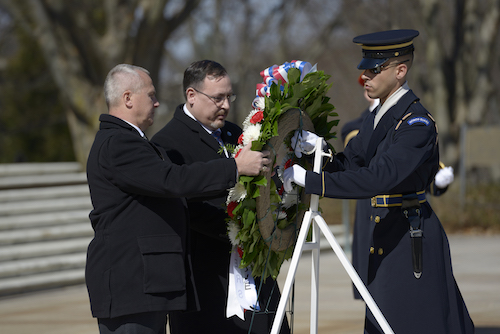There is nothing to break the stark view from the Tomb of the Unknown Soldier. It floats like a white marble ark in a sea of green lawn and small, white-capped grave markers for the thousands of buried troops. All of Washington D.C.’s grand monuments are hidden from sight across the Potomac from Arlington National Cemetery.

|
| Stephenson and Richard were assisted by one of the Tomb Sentinels who guard the crypt 24 hours a day in all weather.
|
On Feb. 28, International President Lonnie R. Stephenson and Construction and Maintenance Department Director Mike Richard took their place on the marble stage in front of the tomb.
Stephenson and Richard had been invited to lay a wreath by the Ironworkers, who every year sponsor a handful of ceremonies. Laying a wreath at the tomb is a way to honor the memory and actions of every man and woman who bore arms for the country. The back of the tomb itself reads “Here rests in honored glory an American soldier known but to God.”
“It has been the honor of my life to serve as international president of the IBEW,” Stephenson said. “As I stood there, I not only thought of the men and women who gave everything, I thought about all of the sacrifices that were made to get us here. It was both one of the proudest and the most humbling moments of my life.”
The crypt holds the remains of a man who died in World War I and rises above graves of unknown soldiers killed in action in World War II and Korea. In every other way, the identity of the remains is hidden: where they were from, what branch they served in, their rank, how they died or where. The bodies were chosen at random from among the unidentified, following a custom that had been adopted in many other allied countries after World War I. Their funerals were presided over by presidents – Harding for the World War I unknown and Eisenhower for the World War II and Korea unknowns.
The unknowns are a symbol. They could be a private or a colonel, black, white or Hispanic, a Californian or a Mainer – even man or woman, although given the battlefield restrictions of the times, that likelihood is slim. The unknowns represent everyone who gave everything.
The wreath laying is nearly silent. Stephenson and Richard, a Marine Corps veteran of the first Gulf War, were led by a host Tomb Guard Sentinel, a soldier form the 3rd United States Infantry Regiment,who walk the 21 steps in front of the crypt in rain and snow, darkness and light.
They marched out from the shadow of the columns of the Memorial Coliseum, holding a simple wreath of evergreen. They walked with the sentinel, down a series of stairs, out onto the plaza beyond the chains of the observation area.
The Tomb Sentinel commanded “Present Arms.” The military personnel saluted. Observers placed their right hands on their hearts. Stephenson and Richard placed the wreath on a stand before the crypt, backed away a step and waited in silence.
Then Taps – the quiet bugle call that signals lights out in many American military installations and marks nearly all military funerals – sounded out across the open marble atrium and out into the cloudless winter sky.
“Lonnie has it right. Its humbling to make that walk, see the tomb and all those grave markers and be the one who gets to leave,” Richard said.